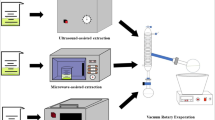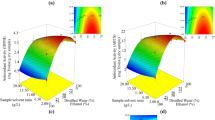Abstract
In this study, optimization of ultrasound-assisted extraction (UAE) conditions was conducted to increase the production of bioactive components from Carthamus tinctorius seeds (CS) using statistically-based optimization. The effects of major independent variables including extraction time (5.0–55.0 min), extraction temperature (26.0–94.0°C), and ethanol concentration (0.0–99.5%) were optimized using central composite design (CCD) to explore conditions that simultaneously maximize total polyphenol content, total flavonoid content, and radical scavenging activity. According to quadratic regression models, the predicted optimum UAE conditions were 33.7 min, 75.1°C, and 68.3% ethanol, respectively. Under these conditions, the experimental results were found to be 9.94 mg gallic acid equivalents/g dry matter (DM) of TPC, 0.28 mg quercetin equivalents/g DM of TFC, and 66.6% of RSA which are in good agreement with the predicted values. CS extract was subjected to LC/MS/MS analysis to analyze components with bioactive activities, and apigenin was determined as the main component. Therefore, we have concluded that UAE is an effective process for extracting antioxidant components and CS extract with bioactive components can be utilized as food, cosmetics, and pharmaceutical materials.
Similar content being viewed by others
Change history
24 December 2022
An Erratum to this paper has been published: https://doi.org/10.1007/s12257-022-1111-8
References
Xu, D., D. Liu, B. Wang, C. Chen, Z. Chen, D. Li, Y. Yang, H. Chen, and M. G. Kong (2015) In situ OH generation from O2− and H2O2 plays a critical role in plasma-induced cell death. PLoS One 10: e0128205.
Li, R., Z. Jia, and M. A. Trush (2016) Defining ROS in biology and medicine. React. Oxyg. Species (Apex) 1: 9–21.
Onukwufor, J. O., B. J. Berry, and A. P. Wojtovich (2019) Physiologic implications of reactive oxygen species production by mitochondrial complex I reverse electron transport. Antioxidants (Basel) 8: 285.
Choi, S. J., E. Cho, E. Cho, Y. Jeong, C. S. Ku, B. Ha, and H. J. Chae (2011) Screening of functional materials from solvent fractions of apple flower leaf extract. Korean Soc. Biotechnol. Bioeng. J. 26: 165–171.
Kovac, S., P. R. Angelova, K. M. Holmström, Y. Zhang, A. T. Dinkova-Kostova, and A. Y. Abramov (2015) Nrf2 regulates ROS production by mitochondria and NADPH oxidase. Biochim. Biophys. Acta 1850: 794–801.
Forrester, S. J., D. S. Kikuchi, M. S. Hernandes, Q. Xu, and K. K. Griendling (2018) Reactive oxygen species in metabolic and inflammatory signaling. Circ. Res. 122: 877–902.
Sim, H., Y. Noh, S. Choo, N. Kim, T. Lee, and J. S. Bae (2021) Suppressive activities of fisetin on particulate matter-induced oxidative stress. Biotechnol. Bioprocess Eng. 26: 568–574.
Jeong, M. J., D. S. Lim, S. O. Kim, C. Park, S. H. Leem, H. Lee, G. Y. Kim, S. J. Jeong, and Y. H. Choi (2022) Protection of oxidative stress-induced DNA damage and apoptosis by rosmarinic acid in murine myoblast C2C12 cells. Biotechnol. Bioprocess Eng. 27: 171–182.
Ding, M. and J. Zou (2012) Rapid micropreparation procedure for the gas chromatographic-mass spectrometric determination of BHT, BHA and TBHQ in edible oils. Food Chem. 131: 1051–1055.
Nasirullah and R. B. Latha (2009) Storage stability of sunflower oil with added natural antioxidant concentrate from sesame seed oil. J. Oleo Sci. 58: 453–459.
Yoon, J. H., S. G. Park, M. J. Lee, J. Y. Park, K. S. Seo, K. C. Woo, and C. E. Lee (2013) Antioxidant and anti-inflammatory effects of Bletilla striata Reichenbach fil. fractions as cosmetic. J. Life Sci. 23: 1073–1078.
Kang, M. C., W. W. Lee, J. Y. Oh, H. S. Kim, H. G. Lee, and Y. J. Jeon (2017) Thermostability of Ecklonia cava extract on antioxidant activity. J. Mar. Biosci. Biotechnol. 9: 43–48.
Park, S. J., S. W. Song, D. H. Seong, D. S. Park, S. S. Kim, J. Gou, J. H. Ahn, W. B. Yoon, and H. Y. Lee (2009) Biological activities in the extract of fermented Codonopsis lanceolata. J. Korean Soc. Food Sci. Nutr. 38: 983–988.
Kim, J., K. Lee, and Y. S. Nam (2021) Metal-polyphenol complexes as versatile building blocks for functional biomaterials. Biotechnol. Bioprocess Eng. 26: 689–707.
Lee, K. J. and B. H. Um (2008) Extraction of useful component from natural plants using ultrasound system. Korean J. Biotechnol. Bioeng. 23: 101–108.
Lee, K. J., J. Y. Ma, and Y. S. Kim (2012) Identification of curcuminoids from turmeric (Curcuma longa) using ultrasonic wave and dipping method. Korean Soc. Biotechnol. Bioeng. J. 27: 33–39.
Lee, K. J., H. J. Yang, S. W. Jeong, and J. Y. Ma (2012) Solid-phase extraction of curcuminoid from turmeric using physical process method. Korean J. Pharmacogn. 43: 250–256.
Wen, C., J. Zhang, H. Zhang, C. S. Dzah, M. Zandile, Y. Duan, H. Ma, and X. Luo (2018) Advances in ultrasound assisted extraction of bioactive compounds from cash crops - a review. Ultrason. Sonochem. 48: 538–549.
Khan, M. A., S. von Witzke-Ehbrecht, B. L. Maass, and H. C. Becker (2009) Relationships among different geographical groups, agro-morphology, fatty acid composition and RAPD marker diversity in safflower (Carthamus tinctorius). Genet. Resour. Crop Evol. 56: 19–30.
Zemour, K., A. Labdelli, A. Adda, A. Dellal, T. Talou, and O. Merah (2019) Phenol content and antioxidant and antiaging activity of safflower seed oil (Carthamus tinctorius L.). Cosmetics 6: 55.
Delshad, E., M. Yousefi, P. Sasannezhad, H. Rakhshandeh, and Z. Ayati (2018) Medical uses of Carthamus tinctorius L. (Safflower): a comprehensive review from Traditional Medicine to Modern Medicine. Electron. Physician 10: 6672–6681.
Hidayat, M. A., D. A. Maharani, D. A. Purwanto, B. Kuswandi, and M. Yuwono (2020) Simple and sensitive paper-based colorimetric biosensor for determining total polyphenol content of the green tea beverages. Biotechnol. Bioprocess Eng. 25: 255–263.
Ruslan, K., S. Happyniar, and I. Fidrianny (2018) Antioxidant potential of two varieties of Sesamum indicum L. collected from Indonesia. J. Taibah Univ. Med. Sci. 13: 211–218.
Kim, H., Y. Jeong, J. E. Kim, Y. G. Kim, N. S. Paek, and C. H. Kang (2021) Anti-obesity potential of Lactobacillus spp. isolated from infant feces. Biotechnol. Bioprocess Eng. 26: 575–585.
Min, D. L., S. Lim, J. B. Ahn, and Y. J. Choi (2010) Optimization of ethanol extraction conditions for antioxidants from Zizyphus jujuba Mill. leaves using response surface methodology. Korean J. Food Sci. Technol. 42: 733–738.
Jo, I. H., C. Y. Kim, T. W. Lee, G. H. Lee, and Y. H. Choi (2010) Optimization of extraction of effective components from Vitis coignetiae, the crimson glory vine. Korean J. Food Preserv. 17: 659–666.
Kim, S. H., I. H. Kim, B. H. Kang, K. H. Lee, S. H. Lee, D. S. Lee, S. K. Cho, S. S. Hur, T. K. Kwon, and J. M. Lee (2009) Optimization of ethanol extraction conditions from propolis (a bee product) using response surface methodology. Korean J. Food Preserv. 16: 908–914.
Koh, Y. J., D. S. Cha, H. D. Choi, Y. K. Park, and I. W. Choi (2008) Hot water extraction optimization of dandelion leaves to increase antioxidant activity. Korean J. Food Sci. Technol. 40: 283–289.
Park, M. G. and S. Y. Joo (2021) Comparison of antioxidant activities of sea buckthorn (Hippophae rhamnoides) leaf extracts at different ethanol ratios. Korean J. Food Sci. Technol. 53: 55–62.
Park, S. J. (2019) Antioxidant activities and whitening effects of ethanol extract from Panax ginseng sprout powder. J. Korean Soc. Food Sci. Nutr. 48: 276–281.
Lee, E. K., H. G. Hong, and M. S. Chong (2009) Study on the comparison of effects by extraction methods of roast and raw semen zizyphi spinosae. Korean J. Orient. Physiol. Pathol. 23: 1416–1422.
Min, B. R., Y. J. Han, D. K. Lee, H. J. Jung, J. M. Jo, and J. W. Kim (2018) Optimization of microwave-assisted extraction conditions for production of bioactive material from corn stover. Korean Chem. Eng. Res. 56: 66–72.
Woo, K. S., S. B. Song, B. G. Oh, M. C. Seo, J. Y. Ko, J. S. Lee, J. R. Kang, M. H. Nam, and H. S. Jeon (2009) Antioxidant activity of ethanol extracts from horseweed (Erigeron canadensis L.) with pretreatment conditions. J. Korean Soc. Food Sci. Nutr. 38: 1279–1283.
Chung, K.H. and B.G. Park (2013) Biodiesel production from waste oils mixed with animal tallows and vegetable oil by transesterification using ultrasonic irradiation. Korean Chem. Eng. Res. 51: 487–492.
Kim, D. I. and J. H. Hong (2012) Optimization of ethanol extraction conditions for functional components from Lespedeza cuneata using response surface methodology. Korean J. Food Cook. Sci. 28: 275–283.
Shin, Y. J., J. M. Hwang, and S. C. Lee (2013) Antioxidant and xanthine oxidase inhibitory activities of hot water extracts of medicinal herbs. J. Korean Soc. Food Sci. Nutr. 42: 1712–1716.
Kim, H. Y., K. S. Woo, I. G. Hwang, Y. R. Lee, and H. S. Jeong (2008) Effects of heat treatments on the antioxidant activities of fruits and vegetables. Korean J. Food Sci. Technol. 40: 166–170.
Kang, K. J., B. H. Kim, D. Kim, H. J. Yun, Y. S. Cho, N. E. Han, J. C. Choi, S. Lee, and O. K. Choi (2021) Determination of the contents of apigenin and luteolin in vegetables. Korean J. Food Nutr. 34: 233–241.
Huang, W. Y., Y. Z. Cai, and Y. Zhang (2009) Natural phenolic compounds from medicinal herbs and dietary plants: potential use for cancer prevention. Nutr. Cancer 62: 1–20.
Brglez Mojzer, E., M. Knez Hrnčič, M. Škerget, Ž. Knez, and U. Bren (2016) Polyphenols: extraction methods, antioxidative action, bioavailability and anticarcinogenic effects. Molecules 21: 901.
Author information
Authors and Affiliations
Corresponding author
Ethics declarations
The authors declare no conflict of interest.
Neither ethical approval nor informed consent was required for this study.
Additional information
Publisher’s Note Springer Nature remains neutral with regard to jurisdictional claims in published maps and institutional affiliations.
Rights and permissions
About this article
Cite this article
Kim, J.H., Yeom, S.H., Hwang, Y.S. et al. Ultrasound-assisted Extraction of Polyphenols from Carthamus tinctorius Seeds: Optimization of Process Variables. Biotechnol Bioproc E 27, 869–878 (2022). https://doi.org/10.1007/s12257-022-0092-y
Received:
Revised:
Accepted:
Published:
Issue Date:
DOI: https://doi.org/10.1007/s12257-022-0092-y




